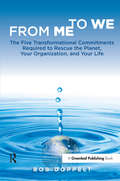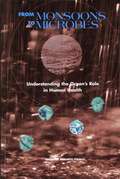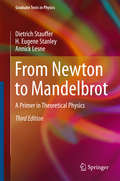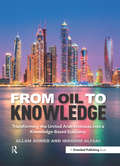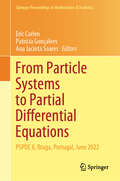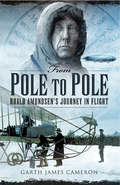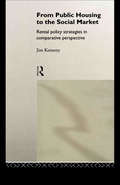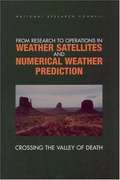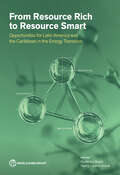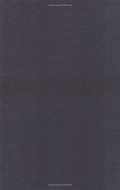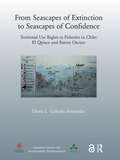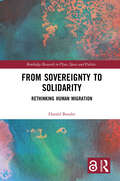- Table View
- List View
From Kinetic Theory to Turbulence Modeling: The Legacy of Carlo Cercignani (Springer INdAM Series #51)
by Paolo Barbante Francesco D. Belgiorno Silvia Lorenzani Lorenzo ValdettaroThe book collects relevant contributions presented at a conference, organized in honour of Carlo Cercignani, that took place at Politecnico di Milano on May 24–28, 2021. Different research areas characterizing the scientific work of Carlo Cercignani have been considered with a particular focus on: mathematical and numerical methods for kinetic equations; kinetic modelling of gas mixtures and polyatomic gases; applications of the Boltzmann equation to electron transport, social phenomena and epidemic spread; turbulence modelling; the Einstein Classical Program; Dynamical Systems Theory.
From Land Disputes to Sustainable Environmental Development: A Near East Perspective
by Ozay Mehmet Vedat YorucuThis book is written to transform land disputes toward win-win outcomes utilizing the latest sustainable development theory. Land has always been a source of conflict, a contest of competing homelands and ideologies, but it can also act as an agency of peace-making, promoting economic and social development. This dualism will be the theme of this book as there is a dearth of studies exclusively focused on land. The book's coverage is comprehensive, examining land and property disputes with case studies in modern times along with a problem-solving approach utilizing such economic theorems as Location and Growth Poles theories. The UN’s Sustainable Development Goals will be used as our over-arching framework. The overall aim of the book is to transform land disputes toward win-win outcomes utilizing latest sustainable development theory.
From Local Patriotism to a Planetary Perspective: Impact Crater Research in Germany, 1930s-1970s (Science, Technology and Culture, 1700-1945)
by Martina Kolbl-EbertThe Nördlinger Ries and Steinheim Basin, two conspicuous geological structures in southern Germany, were traditionally viewed as somewhat enigmatic but nevertheless definitely volcanic edifices until they were finally recognized as impact craters in the 1960s. The changing views about the origin of the craters mark an important paradigm shift in the Earth sciences, from an Earth-centric approach to a planetary perspective that acknowledged Earth’s place in the wider cosmos. Drawing on a range of printed sources, detailed archival material, letters, personal notes, and interviews with veterans of Ries research, Martina Kölbl-Ebert provides a detailed reconstruction, not only of the historical sequence of events throughout the twentieth century, but also of the personal thoughts, emotions and motives of the scientists involved and the social context of their research. She shows that there was a sudden reconnection of German researchers with the international scientific community, particularly with more progressive American researchers, after some twenty-five years of scientific isolation during the build-up to WWII and its aftermath. This reconnection brought about not only a new view of geoscience, but also saved German geology from self-sufficiency and patriotic arrogance by integrating it in an interdisciplinary and international framework. In so doing this book sheds much valuable light on an under-explored but crucial development in the way we understand Earth’s history, as well as the way that science functioned during times of conflict.
From Mass Prefab to Mass Customization: Modern Methods of Constructions from Experimentation to Manufacturing (SpringerBriefs in Applied Sciences and Technology)
by Ornella IuorioThis book provides an overview of the latest innovations in prefabrication. It analyzes how digital, material, and process innovations are transforming the mass prefabrication of homes, schools, and offices into mass customization. It provides an understanding of available manufacturing processes, including distributed ownership of manufacturing, platform approaches, and robotics. It discusses how the integration of cutting-edge advanced construction techniques, coupled with robotic manufacturing and assembly from the earliest stages of building system design, has the potential to unlock new formal and technical paradigms. Investigating the impact of prefab in the context of climate emergency, the book analyzes the capacity and shortfall in delivering net zero emissions. It discusses the opportunities that Modern Methods of Construction provide to enable the transition towards circular constructions, from reuse to retrofitting. Including the users' experience, it demonstrates the importance of developing methodologies for capturing users' occupancy evaluation, as a means for understanding real performances, benchmarking indicators, and tuning systems to target the long-term well-being of the occupants. Referring to a plethora of emblematic cases, this work demonstrates the importance of investing in research and development to optimize construction systems, reduce material use, facilitate lean construction, advance mechanical and environmental performances, and move toward circular systems to close the loop. This book is aimed at practitioners, architects, technologists, researchers, and students in architectural engineering.
From Me to We: How Shared Value Can Turn Companies Into Engines of Change
by Jerry Haar Ricardo ErnstShared value is a management strategy in which companies find business opportunities in social problems. While philanthropy and CSR focus efforts focus on “giving back” or minimizing the harm business has on society, shared value focuses company leaders on maximizing the competitive value of solving social problems in new customers and markets, cost savings, talent retention, and more.This book takes the concept of shared value to the next level, with the concept of “Me to We” (also abbreviated as “M2W”) and discusses the current state of the business-environment-government relationship and shows how the shared value model can contribute to each entity. Citing real cases and examples from multiple industries, the authors show that shared value promotes shareholder interests while serving as a successful business strategy. Chapters explore the emerging phenomenon of shared value, the shareholder-stakeholder comparisons, the role of government in the stakeholder environment, shared value as it related to competitiveness, and operational issues such as implementation, communication, and leadership in their relationship to shared value.Readers will find useful strategies of Me to We and its implementation by firms that have become leaders in their market. They will receive ideas and insights into business strategies that will overshadow CSR activities as a differentiation or brand development strategy of the past.Featuring interviews with corporate executives offering their perspectives on shared value, this book will discuss shared value within the context of business and society, competitiveness, and globalization.
From Me to We: The Five Transformational Commitments Required to Rescue the Planet, Your Organization, and Your Life
by Bob DoppeltIn From Me to We: The Five Transformational Commitments Required to Rescue the Planet, Your Organization, and Your Life, systems change expert Bob Doppelt reveals that most people today live a dream world, controlled by false perceptions and beliefs. The most deeply held illusion is that all organisms on Earth, including each of us, exist as independent entities. At the most fundamental level, the change needed to overcome our misperceptions is a shift from focusing only on "me" – our personal needs and wants – to also prioritizing the broader "we": the many ecological and social relationships each of us are part of, those that make life possible and worthwhile. Research shows that by using the techniques described in this book this shift is possible – and not that difficult to achieve. From Me to We offers five transformational "commitments" that can help you change your perspective and engage in activities that will help resolve today's environmental and social problems. Not coincidentally, making these commitments can improve the quality of your life as well. Bob Doppelt's latest book is a wake-up call to the creed of individualism. He calls for recognition of the laws of interdependence, cause and effect, moral justice, trusteeship, and free will. The book will be essential to all of those interested in how we can create and stimulate a sea change in how to enable the necessary behavioral change we need to deal with the myriad environmental and social pressures consuming the planet.
From Monsoons to Microbes: Understanding the Ocean's Role in Human Health
by National Research CouncilWhat can sharks teach us about our immune system? What can horseshoe crabs show us about eyesight?The more we learn about the ocean, the more we realize how critical these vast bodies of water are to our health and well-being. Sometimes the ocean helps us, as when a marine organism yields a new medical treatment. At other times, the ocean poses the threat of coastal storm surges or toxic algal blooms.From Monsoons to Microbes offers a deeper look into the oceans that surround us, often nuturing yet sometimes harming humankind. This book explores the links among physical oceanography, public health, epidemiology, marine biology, and medicine in understanding what the ocean has to offer. It will help readers grasp such important points as: How the ocean's sweeping physical processes create long-term phenomena such as El Nino and short-term disastrous events such as tsunamis--including what communities can do to prepare.What medicines and nutritional products have come from the ocean and what the prospects are for more such discoveries.How estuaries work--where salt and fresh water meet--and what can go wrong, as in the 7,000 square mile "dead zone" at the out-flow of the Mississippi River.How the growing demand for seafood and the expansion of ocean-going transport has increased our exposure to infectious agents--and how these agents can be tracked down and fought.Why "red tides" of toxic algae suddenly appear in previously unaffected coastal areas, and what happens when algal toxins find their way into our food supply or the air we breathe. The book recommends ways we can implement exciting new technologies to monitor the physics, chemistry, and biology of the ocean to recognize change as it happens. From the impact of worldwide atmospheric warming to the significance of exotic bacteria from submarine hydrothermal vents, the ocean has many depths left to explore.
From Newton to Mandelbrot
by H. Eugene Stanley Dietrich Stauffer Annick LesneThis textbook takes the reader on a tour of the most important landmarks of theoretical physics: classical, quantum, and statistical mechanics, relativity, electrodynamics, as well as the most modern and exciting of all: elementary particles and the physics of fractals. The second edition has been supplemented with a new chapter devoted to concise though complete presentation of dynamical systems, bifurcations and chaos theory. The treatment is confined to the essentials of each area, presenting all the central concepts and equations at an accessible level. Chapters 1 to 4 contain the standard material of courses in theoretical physics and are supposed to accompany lectures at the university; thus they are rather condensed. They are supposed to fill one year of teaching. Chapters 5 and 6, in contrast, are written less condensed since this material may not be part of standard lectures and thus could be studied without the help of a university teacher. An appendix on elementary particles lies somewhere in between: It could be a summary of a much more detailed course, or studied without such a course. Illustrations and numerous problems round off this unusual textbook. It will ideally accompany the students all along their course in theoretical physics and prove indispensable in preparing and revising the exams. It is also suited as a reference for teachers or scientists from other disciplines who are interested in the topic.
From Oil to Knowledge: Transforming the United Arab Emirates into a Knowledge-Based Economy
by Allam Ahmed Ibrahim AlfakiOver-reliance on oil challenges the long-term sustainability of an economy. The UAE’s government has placed considerable focus on a comprehensive strategic planning exercise to transform the country’s economic structure from relying heavily on hydrocarbon resources to becoming a knowledge-based economy. Non-oil is to account for 80% of the country’s economy by 2021. From Oil to Knowledge examines the role of this major powerhouse of the Arab World to transform itself into a leader in the adoption of science, technology and innovation to drive economic success on the international stage.In this first book to present and critically evaluate the extent of the UAE’s success in diversifying its economy and implementing the principles and approaches of a Knowledge Economy, the authors identify the achievements of the government to date and the areas of further development. From Oil to Knowledge will be utilized as a guide by policymakers and senior managers to enhance their ability to think strategically towards implementing the pillars of a Knowledge Economy within their own organisations and nation states.
From Particle Systems to Partial Differential Equations: PSPDE X, Braga, Portugal, June 2022 (Springer Proceedings in Mathematics & Statistics #465)
by Patrícia Gonçalves Ana Jacinta Soares Eric CarlenThis book presents the proceedings of the international conference Particle Systems and Partial Differential Equations X, which was held at the University of Minho, Braga, Portugal, from 2022. It includes papers on mathematical problems motivated by various applications in physics, engineering, economics, chemistry, and biology.
From Plant to Plate: Turn Home-Grown Ingredients Into Healthy Meals!
by Ella Phillips Darryl GadzekpoGrow mighty ingredients, then take them from mud kitchen to real kitchen and transform them into delicious, plant-powered feasts.Grab your shovel and plant for a recipe! Discover 15 incredible plants, including zucchini, raspberries, corn, and basil, then find out what it takes to make them grow. From showing you how seeds should be properly planted to helping you find the best soil for your plants, Darryl Gadzekpo and Ella Phillips offer all the tips and tricks green-fingered kids need to know to transform seeds into mighty fruit, vegetables, and herbs your tummies would be proud of.But the fun doesn't end here! Once you've removed those muddy boots, head to the kitchen and learn how to prepare and cook your home-grown ingredients. With more than 25 tasty recipe ideas from basil pesto pasta to butternut squash muffins, you'll master a variety of unique plant-powered food that you'll love to eat as much as you love to cook.A visual feast for 7–9-year-olds, From Plant to Plate is the perfect book to inspire kids to get growing, get cooking, and get plant-powered eating.
From Pole to Pole: Roald Amundsen's Journey in Flight
by Garth James CameronRoald Amundsen (1872-1928) was the most successful polar explorer of his era using sledges, dogs, ski and ships. He is mainly remembered for being the first man to reach the South Pole on 14 December 1911. What is less often remembered is that he was also the first man to reach the North Pole on 12 May 1926 as the leader of the Amundsen- Ellsworth-Nobile expedition in the airship Norge. His involvement in aviation from 1909 to his death in 1928, has not been the subject of a detailed study until now.This book explores Amundsen's enthusiasm for flight from the moment he read about Bleriot's flight across the English Channel in an aeroplane on 25 July 1909. From that moment onwards he saw the potential of aircraft as vehicles to explore portions of the globe that remained unexplored in the first quarter of the 20th century. The man-lifting kites built by Einar Sem-Jacobsen took the life of his second in command, Ole Engelstad and were carried, but not used, during his 1910-1912 expedition to the South Pole. He saw aeroplanes flying in America and Germany in 1913 and in 1914 he was taught to fly by Sem-Jacobsen. He passed his flight test on a Farman Longhorn biplane on 1 June 1914 and in mid-1915 was issued with the Fédération Aéronautique Internationale (Norge) aeroplane pilot's certificate number one. He bought a Farman biplane to take with him on an expedition to the North Polar Sea but the outbreak of the Great War stopped the Expedition and Amundsen gave his Farman to the Norwegian government. After the war he acquired a Curtiss Oriole biplane and two Junkers F13's then in 1925 he embarked on a flight, which he barely survived, to the North Pole in two Dornier Wal flying boats. 1926 brought long delayed success when the Norge flew to the Pole and on to Alaska. On 18 June 1928 he and five companions took off from Tromso on a search and rescue flight for the missing airship Italia and were never seen again.
From Political to Economic Awakening in the Arab World
by Francisco H. G. Ferreira Julian Messina Jamele Rigolini Luis-Felipe López-Calva Maria Ana Lugo Renos VakisThe popular grievances that have fueled the Arab Spring since 2010 demonstrate that past development paradigms have failed to achieve the inclusive and sustainable growth expected by Arab populations. Countries in the Middle East and North Africa (MENA) region have failed to develop a strong private sector that is linked with global markets, survives without state assistance, and generates productive employment for young people. One key symptom of this maldevelopment is that, with the exception of the petroleum sector, MENA remains the least trade-integrated region in the world. The Deauville Partnership, launched by the Group of Eight (G8) in Deauville, France, in May 2011, is thus strategic and timely. At the request of the G8, this report provides an analytical framework for increasing trade and foreign direct investment (FDI) for Egypt, Jordan, Libya, Morocco, and Tunisia (the Partnership countries). Increased trade and FDI is a key means by which Partnership countries can achieve a path of sustainable growth that reduces youth unemployment. Moreover, trade and investment can also show short-term results. The G8 countries, Turkey, the Gulf states, and other Deauville partners can help the new Arab democracies achieve their objectives in two main ways: by effectively expanding market opportunities and by supporting domestic regulatory reforms. To start implementing a long-term vision of increased trade and investment integration, based on an integrated economic space in the Mediterranean basin, the Deauville Partnership could focus on five priority areas. These are helping Partnership countries adapt to a fast-changing trade, FDI, and jobs landscape; improving market access opportunities and market regulations; fostering competitiveness, diversification, and employment; facilitating trade and mobilizing trade finance and diaspora resources; and promoting inclusiveness, equity, and sustainability of the structural transformation brought about by the process of integration. The success of the Arab political awakening will greatly depend on the emergence of such an economic awakening that can generate quality employment for the millions of young Arab men and women who seek jobs and a decent life.
From Populations to Ecosystems: Theoretical Foundations for a New Ecological Synthesis (MPB-46) (Monographs in Population Biology #46)
by Michel LoreauThe major subdisciplines of ecology--population ecology, community ecology, ecosystem ecology, and evolutionary ecology--have diverged increasingly in recent decades. What is critically needed today is an integrated, real-world approach to ecology that reflects the interdependency of biodiversity and ecosystem functioning. From Populations to Ecosystems proposes an innovative theoretical synthesis that will enable us to advance our fundamental understanding of ecological systems and help us to respond to today's emerging global ecological crisis. Michel Loreau begins by explaining how the principles of population dynamics and ecosystem functioning can be merged. He then addresses key issues in the study of biodiversity and ecosystems, such as functional complementarity, food webs, stability and complexity, material cycling, and metacommunities. Loreau describes the most recent theoretical advances that link the properties of individual populations to the aggregate properties of communities, and the properties of functional groups or trophic levels to the functioning of whole ecosystems, placing special emphasis on the relationship between biodiversity and ecosystem functioning. Finally, he turns his attention to the controversial issue of the evolution of entire ecosystems and their properties, laying the theoretical foundations for a genuine evolutionary ecosystem ecology. From Populations to Ecosystems points the way to a much-needed synthesis in ecology, one that offers a fuller understanding of ecosystem processes in the natural world.
From Public Housing Soc Market
by J KemenyJim Kemeny develops a conceptual framework to present a critical study of comparative rental markets. The framework centres around the concept of the process of maturation of cost rental housing and two policies for handling this which have been adopted by industrial societies. These are, firstly, the Anglo-Saxon "dualist" system, seen in Great Britain, Australia and New Zealand, and secondly, the Germanic "unitary market" system, seen in Sweden, The Netherlands, Germany and Switzerland. Using a comparative approach based around international case studies, Jim Kemeny shows how each system stems from different power structures, is governed by different policy strategies, and is informed by different ideological views of how markets operate. Offering a radical critique of the orthodox view, it is argued that the time is now right for English-speaking nations to abandon state control over cost renting but allow to it to compete directly with profit renting, as in the "unitary market" model. International in scope, this volume should be of interest to researchers in housing, sociology and related fields.
From Research To Operations In Weather Satellites And Numerical Weather Prediction: Crossing The Valley Of Death
by Board on Atmospheric Sciences ClimateThis workshop report examines the capability of the forecast system to efficiently transfer weather and climate research findings into improved operational forecast capabilities. It looks in particular at the Environmental Modeling Center of the National Weather Service and environmental observational satellite programs. Using these examples, the report identifies several shortcomings in the capability to transition from research to operations. Successful transitions from R&D to operational implementation requires (1) understanding of the importance (and risks) of the transition, (2) development and maintenance of appropriate transition plans, (3) adequate resource provision, and (4) continuous feedback (in both directions) between the R&D and operational activities.
From Resource Rich to Resource Smart: Opportunities for Latin America and the Caribbean in the Energy Transition
by Guillermo Beylis Nancy Lozano GraciaCountries that successfully capitalize on ever-advancing technologies and the growing consumer demand for sustainable products will deliver meaningful benefits to their people and economies. Drawing on best-in-class analytics, this book identifies specific areas of opportunity and concrete actions that countries in the Latin American and Caribbean region can take to reap the upside of the energy transition. The policy implications are clear: Transforming Latin America's economic landscape will require concerted and coordinated efforts by governments to strengthen institutions, ensure that the investment climate incentivizes capital flows to green priorities, and support the ongoing development of an innovation ecosystem that drives the net-zero transition. The global transition to a net-zero economy opens a window of opportunity for the Latin America and the Caribbean region. This report offers a roadmap to turn this potential into reality.
From Resource Scarcity to Ecological Security: Exploring New Limits to Growth
by Dennis Pirages Ken CousinsA new recognition of profound interconnections between social and natural systems is challenging conventional constructs and the policy predispositions informed by them. Our current intellectual challenge is to develop the analytical and theoretical underpinnings of an understanding of the relationship between the social and the natural systems. Our policy challenge is to identify and implement effective decision-making approaches to managing the global environment.
From Seascapes of Extinction to Seascapes of Confidence: Territorial Use Rights in Fisheries in Chile: ElQuisco and Puerto Oscuro
by Gloria L. FernandezFrom Seascapes of extinction to seascapes of confidence. Territorial Use Rights in Fisheries in Chile: El Quisco and Puerto Oscuro by Gloria Gallardo Fernandés is an important contribution to our understanding of the multifaceted challenges underlying sustainable solutions to ecological fisheries, the book describes how, in Chile, indiscriminate harvest of the edible shellfish Concholepas concholepas (false abalone or Loco), has been threatening not only the living of small-scale artisan fishers but also the ecosystem. In an attempt to strengthen the fishers’ livelihoods and at the same time recuperate the fish, the Chilean government introduced the regulatory measure: Management and Exploitation Areas for Benthic Resources (MEABRs), locally known as Management Areas (MAs) and internationally as Territorial Use Rights in Fisheries (TURFs).
From Seascapes of Extinction to Seascapes of Confidence: Territorial Use Rights in Fisheries in Chile: ElQuisco and Puerto Oscuro
by Gloria L. FernandezFrom Seascapes of extinction to seascapes of confidence. Territorial Use Rights in Fisheries in Chile: El Quisco and Puerto Oscuro by Gloria Gallardo Fernandés is an important contribution to our understanding of the multifaceted challenges underlying sustainable solutions to ecological fisheries, the book describes how, in Chile, indiscriminate harvest of the edible shellfish Concholepas concholepas (false abalone or Loco), has been threatening not only the living of small-scale artisan fishers but also the ecosystem. In an attempt to strengthen the fishers’ livelihoods and at the same time recuperate the fish, the Chilean government introduced the regulatory measure: Management and Exploitation Areas for Benthic Resources (MEABRs), locally known as Management Areas (MAs) and internationally as Territorial Use Rights in Fisheries (TURFs).
From Seed to Plant (Journeys 2014)
by Gail GibbonsFlowers, trees, fruits—plants are all around us, but where do they come from? With simple language and bright illustrations, non-fiction master Gail Gibbons introduces young readers to the processes of pollination, seed formation, and germination. Important vocabulary is reinforced with accessible explanation and colorful, clear diagrams showing the parts of plants, the wide variety of seeds, and how they grow. The book includes instructions for a seed-growing project, and a page of interesting facts about plants, seeds, and flowers. A nonfiction classic, and a perfect companion for early science lessons and curious young gardeners. According to The Washington Post, Gail Gibbons "has taught more preschoolers and early readers about the world than any other children's writer-illustrator." Ms. Gibbons is the author of more than 100 books for young readers, including the bestselling titles From Seed to Plant and Monarch Butterfly. Her many honors include the Washington Post/Childrens Book Guild Nonfiction Award and the NSTA Outstanding Science Trade Book Award. From Seed to Plant was included in the Common Core State Standards Appendix B.
From Sovereignty to Solidarity: Rethinking Human Migration (Space Power and Politics)
by Harald BauderFrom Sovereignty to Solidarity seeks to re-imagine human mobility in ways that are de-linked from national sovereignty. Using examples from around the world, the author examines contemporary practices of solidarity to illustrate what such a conceptualization of human mobility looks like. He suggests that urban and local scales, rather than the national scale, is a better way to frame human migration and belonging. The book ultimately proposes that solidarity, rather than sovereignty, offers an alternative approach to imagine how human mobility should, and already does, occur. This book will be relevant to upper-level undergraduate and graduate students in disciplines such as Migration Studies, Urban Studies, Human and Political Geography, and Refugee Studies. It is also relevant to researchers, development workers and human rights/environmental activists, and other intellectual practitioners.
From Special Relativity to Feynman Diagrams
by Riccardo D'Auria Mario TrigianteThis book, now in its second edition, provides an introductory course on theoretical particle physics with the aim of filling the gap that exists between basic courses of classical and quantum mechanics and advanced courses of (relativistic) quantum mechanics and field theory. After a concise but comprehensive introduction to special relativity, key aspects of relativistic dynamics are covered and some elementary concepts of general relativity introduced. Basics of the theory of groups and Lie algebras are explained, with discussion of the group of rotations and the Lorentz and Poincaré groups. In addition, a concise account of representation theory and of tensor calculus is provided. Quantization of the electromagnetic field in the radiation range is fully discussed. The essentials of the Lagrangian and Hamiltonian formalisms are reviewed, proceeding from systems with a finite number of degrees of freedom and extending the discussion to fields. The final four chapters are devoted to development of the quantum field theory, ultimately introducing the graphical description of interaction processes by means of Feynman diagrams. The book will be of value for students seeking to understand the main concepts that form the basis of contemporary theoretical particle physics and also for engineers and lecturers. An Appendix on some special relativity effects is added.
From Stardust to First Cells: The Origin and Evolution of Early Life
by Sankar ChatterjeeThis book presents a groundbreaking hypothesis to answer one of the greatest scientific mysteries: How did life begin? Like a detective piecing together seemingly disparate bits of evidence, Dr. Sankar Chatterjee combines the most recent discoveries in cosmology, geology, chemistry, information systems, and biology, weaving a vast tapestry from the threads of current research. Dr. Chatterjee convincingly argues that the odyssey of life first began when the fundamental building blocks were brought to Earth by meteorites. These cosmic compounds concentrated and simmered like a soup in hydrothermal crater-caldrons. Through a system of subterranean vent networks, a biosynthetic-rich variety of organic compounds mixed and matched into a recipe of rich biomolecules guided by prebiotic information systems. Through symbiosis, these complex biopolymers gradually assemble into membrane-bound protocells. At each stage of this evolutionary progression, through natural selection, they refined with increasing stability and complexity, ultimately leading to the emergence of the first cells about four billion years ago. In this book, Dr. Chatterjee tells this story in rigorous detail in language that is both accessible and engaging.
From Traditional to Modern African Water Management: Lessons for the Future
by Andreas Haarstrick Chrispin Kowenje Timothy Biswick Gideon Ajeagah Stephen Ojwach Oluwatoyin A. Odeku Gnon BabaThis book preserves and scientifically interprets the African foreknowledge on water resources management. It offers insight into the relevance of the traditional knowledge and practices to modern approaches on sustainable water management. The African continent has partially preserved its natural habitat for centuries. In this book, this knowledge is combined with the current scientific understanding. The traditional practices are categorized as: i) water harvesting, ii) water transportation, iii) water storage and conservation, iv) water treatments, v) myths and folk stories about water management or conservation, vi) water resource management systems, and vii) soil–water–forest conservation/management systems sub-topics. The findings presented here are in line with SDG 6, which aims at ensuring availability and sustainable management of water and sanitation for all by the year 2030.





